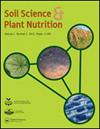通过监测方法揭示了促进植物生长的根杆菌接种后不同的定植和流行策略
IF 1.8
4区 农林科学
Q3 ENVIRONMENTAL SCIENCES
引用次数: 2
摘要
接种后土壤中促进植物生长的根瘤菌(PGPR)的监测至关重要。在常见的PGPR中,氮螺旋藻菌株TSA2s和TSH100具有减轻农业土壤中氧化亚氮(N2O)排放的能力;然而,它们在植物中成功定植并获得有益作用的机制仍然知之甚少。在这里,开发了一个简单而稳健的程序来设计基于这两个菌株的全基因组序列的菌株特异性引物。通过对其特异性和扩增效率的评价,对每个偶氮螺旋藻菌株筛选出3对引物。对红三叶草根际土壤中这两种菌株的定量分析表明,在温室条件下,每种菌株的接种动态不同。其中,接种TSA2s后22、34和41 d,接种剂的种群数量明显大于未接种对照,并在第34天达到最大值。接种后第22天,TSH100菌群规模最大,从接种后第34天开始急剧下降。这些结果表明,不同的PGPR在接种后可能具有不同的定殖和流行策略。在Biolog Eco Micro plate中添加31个根际碳源模拟植物根系分泌物,TSA2s利用了14个,TSH100只利用了1个。接种后,TSA2s对红三叶草根系分泌物的利用更加多样化,其定殖率和流行率均优于TSH100。因此,本研究提出了一种接种后监测PGPR的方法。此外,该方法可以筛选具有更好生存能力和定殖能力的PGPR,从而开发出高效、稳定、标准化的生物肥料。本文章由计算机程序翻译,如有差异,请以英文原文为准。
Different strategies for colonization and prevalence after inoculation with plant growth-promoting rhizobacteria revealed by a monitoring method
ABSTRACT It is critical to monitor plant growth-promoting rhizobacteria (PGPR) in soils after inoculation. Among common PGPR, the Azospirillum sp. strains TSA2s and TSH100 have the ability to mitigate nitrous oxide (N2O) emissions from agricultural soils; however, their mechanism by which they successfully colonize and achieve beneficial effects in plants remains poorly understood. Here, a simple and robust procedure was developed to design strain-specific primers based on the whole-genome sequences of these two strains. After evaluating their specificity and amplification efficiency, three primer pairs were screened for each Azospirillum sp. strain. Quantification of these two strains in the rhizosphere soils of red clover revealed distinct inoculant dynamics for each strain under greenhouse conditions. Specifically, 22, 34, and 41 days after inoculation with TSA2s, the population size of the inoculant was notably greater than that in the non-inoculated control, and reached a maximum at day 34. In contrast, the population size of the TSH100 inoculant was largest at day 22, then decreased dramatically from 34 days after inoculation. These results suggest that different PGPR may have different strategies for colonization and prevalence after inoculation. Of the 31 rhizosphere carbon sources added to the Biolog Eco Micro plate to simulate plant root exudates, TSA2s utilized 14 whereas TSH100 utilized only one. TSA2s utilized more diverse root exudates of red clover, indicating better colonization and prevalence than TSH100 after inoculation. Therefore, this study presents a method of monitoring PGPR after inoculation. Furthermore, this method can screen PGPR with a better ability to survive and colonize, enabling the development of efficient, stable, and standardized biofertilizers.
求助全文
通过发布文献求助,成功后即可免费获取论文全文。
去求助
来源期刊

Soil Science and Plant Nutrition
农林科学-农艺学
CiteScore
4.80
自引率
15.00%
发文量
56
审稿时长
18-36 weeks
期刊介绍:
Soil Science and Plant Nutrition is the official English journal of the Japanese Society of Soil Science and Plant Nutrition (JSSSPN), and publishes original research and reviews in soil physics, chemistry and mineralogy; soil biology; plant nutrition; soil genesis, classification and survey; soil fertility; fertilizers and soil amendments; environment; socio cultural soil science. The Journal publishes full length papers, short papers, and reviews.
 求助内容:
求助内容: 应助结果提醒方式:
应助结果提醒方式:


